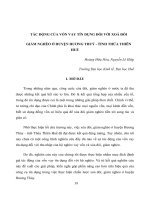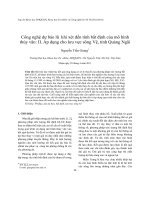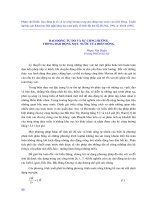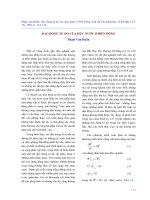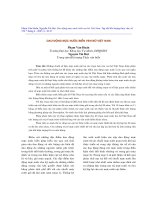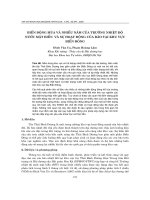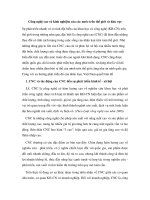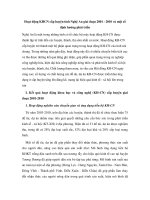Báo cáo nghiên cứu khoa học: "Cộng đồng hành động để hỗ trợ phòng chống sốt rét trong các làng nghề truyền thống tại huyện Hướng Hoá, tỉnh Quảng Trị, Việt Nam" potx
Bạn đang xem bản rút gọn của tài liệu. Xem và tải ngay bản đầy đủ của tài liệu tại đây (50.11 KB, 10 trang )
375
JOURNAL OF SCIENCE, Hue University, N
0
61, 2010
COMMUNITY ACTION TO SUPPORT MALARIA CONTROL IN
TRADITIONAL VILLAGES IN HUONG HOA DISTRICT, QUANG TRI
PROVINCE, VIETNAM
Ho Sy Quang
Medical Committee Netherlands-Vietnam
E. Pamela Wright
Hanoi, Vietnam
SUMMARY
The Vietnamese government has been implementing a national malaria control program
for many years. The program uses several effective strategies but the burden of malaria in poor
and remote communities has not yet reduced. The reasons include reluctance on the part of
some communities, especially ethnic minorities, to use bed nets and change their customary
routines. MCNV supported a community-managed health approach in Huong Hoa,Quang Tri, in
which the villagers themselves identified malaria as a health problem and undertook changes to
reduce their risk. In this report, the activities of villages in the program are compared with those
in villages not involved in the program. Methodology:This was a cross-sectional study in
combination of quantitative and qualitative methods. Four communes in Huong Hoa district,
two with and two without the community-managed health development (CMHD) intervention
program were involved in the study. Results: Significant differences between the CMHD and
non-CMHD communities were found in the levels of new activities undertaken, including
negotiation with authorities for additional bednets, the behavior change for reducing risk of
malaria, and people’s confidence for addressing the malaria problem. In all of these cases, the
CMHD communities were more active than the communities receiving only the NMCP
interventions. Conclusions: The CMHD intervention could empower to change the traditional
routines of the people in the mountainous area. CMHD using participatory planning could also
lead to an effective health promotion, and better functioning of the existing "vertical" programs.
1. Introduction
Vietnam has been praised for its successful fight against malaria over the years,
reducing morbidity by 60% and mortality by 97% between the peak in 1991 and a
decade later. The good results have been maintained through the National Malaria
Control Program (NMCP) (Erhart, et al, 2004; Hung et al, 2002; Schuftan, 2000).
However, in 2007 Vietnam still had more than almost 15,000 registered cases of malaria
and 20 fatalities (WHO Western Pacific Country Profile, 2009). According to the NMCP,
376
half of these cases, more than 90% of the severe cases and 95% of the deaths occur in
the Central Highlands. These areas have been economically attractive for migrants from
other endemic areas, thereby maintaining transmission and re-introduction (Erhart A et
al, 2005). Vietnam shares borders there with Laos and Cambodia, which are both highly
endemic for malaria.
The NMCP is managed by the National Institute for Malariology, Parasitology
and Entomology in Hanoi, and operates through a wide network reaching to the villages.
The responsibility for the program is divided between the health services, which have to
provide good prevention, diagnostic and treatment services, and the community, which
has to use the bed nets provided and be actively involved in other prevention measures.
One obstacle to successful control in the Central Highland areas was reported to be that
villagers did not fully practice the interventions recommended by the NMCP. Another
approach was needed, and community-based approaches have proven to be successful in
other areas of the world in empowering the people and by that, raising their health status.
In the mountainous district of Huong Hoa in Quang Tri province, the Medical
Committee Netherlands-Vietnam (MCNV) introduced a program of community-
managed health development (CMHD), aimed at empowering the village people to
improve their own health by changing their living conditions. Such a program could
supplement the national malaria control strategies for more effective malaria control.
CMHD program is a dynamic bottom-up process aimed at improving people's health
according to their own perception of their needs, in a way appropriate to their local
context. In the CMHD process, the villagers made and implemented their own health
development plans, based on their own analysis of their health situation and largely on
their own resources. In the CHMD communities, people could weave their horizontal
bottom-up planning with the vertical activities supported by the NMCP. Huong Hoa
district consists of 20 communities, all of which receive NMCP, while CMHD provided
additional support to four of them as pilot communes.
The results of this study demonstrate that empowerment led to change in the
traditional routines of the people previously thought to be resistant to change. A
community-managed approach could contribute to better functioning of the existing
national "vertical" disease control program, and increase the effectiveness of health
promotion.
2. Methododology
Four communities in Huong Hoa district, Quang Tri province, were chosen for a
comparison, two with the CMHD program and two without it. All four communities
received the same inputs from the NMCP. The communities were comparable in the
severity of malaria, distance to health services and demographic and socio-economic
conditions (Table 1).
377
Table 8: Key figures of the selected communities
Figures
CMHD communities Non-CMHD communities
Thanh A Tuc A doi Thuan
Population 2745 1983 2653 2288
% of poor households 67% 64% 45% 39%
Income per capita
(USD)
285 307 315 375
% of malnutrition
children under five
48% 38% 38% 41%
Two of the four CMHD communities were selected randomly. Two similar
communities in the neighborhood were selected as control groups. All in the selected
communes were listed and 2 in each commune chosen by random numberings. All
households in the selected villages were asked to complete the questionnaires. Based on
a list of all households in the selected villages, random number method was used to
select 10 villagers in each village for focus group discussion (FGD). In total, 450 people
filled in questionnaires (Thanh 120, A Tuc 90, A Doi 117 and Thuan 123) and 80 people
(50% women) participated in FDG. Both men and women were asked to fill in
questionnaires. Because many of the villagers are illiterate, the research team went to
house to guide the people, also giving them the opportunity to observe all 450
households according to checklists. Additional interviews were conducted with 8 health
workers at commune health centers and 4 health officers at district level.
Secondary data were obtained from the NMCP on: numbers of malaria cases per
community, numbers of bed nets provided and numbers of bed nets used by people;
impregnation of bed nets in all four communities. Other data were collected from the
reports of CMHD program and reports of the NMCP.
Data analysis: The data were entered into EPI Info. Data from each group was
pooled for comparison using Chi square test.
3. Results
3.1. Household interventions against malaria
Differences in practice of interventions between the CMHD and non-CMHD
villages are shown in Table 2. The interventions listed were based on what people
planned to change according to their perception of risks. For example, one reason for
not using bed nets regularly was the presence of an open fire for cooking and warmth in
the middle of the house. Sleeping near the fire is dangerous with a bed net. Families that
had already a separate kitchen could use a bed net better. More villagers in CMHD
378
communities also made a shed, and moved livestock from under the house (on stilts),
than did villagers in non-CMHD villages. The rates of impregnating bed nets and
spraying were similar in communities with and without CMHD.
Table 2. Household Interventions in CMHD and non-CMHD communities
Household
Interventions
CMHD
communities
Non-CMHD
communities
P value
Yes
n (%)
No
n (%)
Yes
n (%)
No
n (%)
Use bed nets
207
(99%)
3 (1%)
212
(88%)
58 (12%) P<0.00
Made separate kitchen,
moved fire out of living
area
172
(82%)
38 (18%)
158
(66%)
82 (34%) P<0.00
Made shed, moved
cattle or livestock from
under house
128
(61%)
82 (39%) 76 (32%) 164 (68%) P<0.00
Cleared stagnant water
or livestock feces near
house
177
(84%)
33 (16%)
135
(56%)
105 (44%) P<0.00
These results show that the households in CMHD communities more often used
bed nets, more often moved the fire place out of the living area, more often moved
livestock out from under their houses, and more often cleared potential breeding places
for mosquito larvae from around their houses. Matching results from the questionnaires
and observation checklists revealed no effect of literacy on practice in use of a bed net
(data not shown).
3.2. Response to community plans
In the FGD, villagers in CMHD communities said that in the beginning of the
CMHD, many of them did not believe in action would be taken. So when their first plan
was evaluated, in a participatory way that involved them, they were excited about the
results. Villagers expressed that they were much stronger in group than they were as
individuals. After the first cycle of planning their village interventions, they had more
confidence for the next cycle. One group in A Tuc community reported that they had
seen how it worked and had the impression that it could work on other problems.
The district health officers noted that "leaders of villagers with CMHD
programs came to the district authorities at least three times a year to negotiate for
379
their village's needs. The district health workers could reduce monitoring visits on the
malaria control program to CMHD communities due to the active participation of
villagers who had taken responsibility for the village actions."
Both CMHD and non-CMHD villages reported that the NMCP policy of
providing one bed net per 2.2 people was not appropriate, because of cultural customs
of these communities. They could not afford to buy extra nets. The CMHD communities,
however, were empowered enough to negotiate with the NMCP for more bed nets for
their households, so they could have sufficient for nearly everyone to sleep under a net.
3.3. How non-CMHD communities addressed malaria problems
Villagers in the FGD in non-CMHD communities said that they felt that the
NMCP was successful, but it was not enough. They participated in the implementation
when asked by health staff and village leaders. But they saw the neighboring CMHD
communities doing more and wanted to follow; however, they were not yet skilled in
planning, monitoring and working together as the CMHD communes. The non-CMHD
villagers reported that a few of the households had copied good examples from families
in CMHD-communities, such as making a separate kitchen and relocating the fire to
make the use of bed net safer. We have no data yet on the extent of this copying or its
effect on the results in the other sections.
3.4. Community participation and behavior change
Level of participation in controlling malaria
People in CMHD communities appeared to have more control in the
development of their community. To check this, a frame-work of five levels of
participation (1) making decision and plan, (2) monitoring and evaluation, (3)
implementing, (4) contributing labor, material or money, and (5) only benefiting, was
applied to measure the participation of people in these four communities in malaria
control activities. More people in CMHD communities participated in the highest level
(making decisions) compared to those in non-CMHD, while more people in non-CMHD
community were at the lowest level of participation. There was a significant difference
in participation at the highest and lowest levels between two groups (p<0.00), however
there was not much difference in the immediate levels among both groups; 39% of
people in CMHD communities reported that they participated in decision making,
compared to only 0.4% of people in non-CMHD villages. Only 2.9% of people in
CMHD communities reported that they were at the lowest level of participation,
compared to 9.2% in non-CMHD communities. From the questionnaires, there was no
significant difference between literate and illiterate villagers’ participation in malaria
control activities.
380
Higher level of participation, better use of bed nets
The villagers’ levels of participation in malaria control appeared to influence
their use of bed nets (Figure 1 (p<0.00). The lowest proportion of bed net use reported
in the questionnaires (71%) was found among those whose participation was at the
lowest level (passive benefit only); those who participated at the highest level also
reported the highest level of bed net use (100%).
100%
97%
71%
0%
20%
40%
60%
80%
100%
Highest level High level Lowest level
Figure 5. Relation between villagers’ bed net use and level of participation
3.5. People’s perception of change in malaria burden
The perception of people about the seriousness of malaria burden four years ago
compared to the present was significantly correlated with the number of interventions
taken in both CMHD and non-CMHD communities (p<0.02). In the CMHD
communities, 83% of the villagers were convinced that malaria was reduced, while 13%
did not know. In the non-CMHD communities, 72% thought that malaria had been
reduced, and 23% had no idea. The difference between percentages of people who said
the malaria situation was unchanged or had increased was only 4% and 5% in CMHD-
communities and non-CMHD communities respectively.
In the FGD, villagers in CMHD communities agreed that malaria and its impact
had been reduced in their communities. They said that in previous years, many of them
could not work because of malaria but that was no longer the case. Many had had
serious fevers for three or four times a year, and in some families two or three members
got malaria at the same time. When so many members could not work, their families
had food shortages. Now, they said, the number of people getting malaria in families
and community was reduced. They could go to work and no longer suffered food
shortages. Also, more villagers went to the commune health centers immediately to get
treatment if they thought they had malaria. The main malaria problem now was with
people who went to work in the forest and did not use bed nets there, or who crossed the
border to visit relatives in Laos.
381
According to the NMCP report of Huong Hoa district, the incidence of malaria
in this area in 2006 was higher than in 2005. In the non-CMHD communities, malaria in
Thanh community increased from 125 cases in 2005 to 169 in 2006 and in Thuan
community, from 82 in 2005 to 89 in 2006. In the CMHD communities, the number of
cases in A Tuc decreased from 63 in 2005 to 46 in 2006, but in A Doi there were 84
cases in 2005 and 106 in 2006. During interviews with commune health workers and
FGD with district health officers, it was noted that the improved awareness of villagers
made them go to a commune health center when they got fever, which can result in an
increase in the number of cases recorded at the health services. But, in fact, they thought
that the malaria burden was less than it had been in the previous years. Villagers in
CMHD communes also reported in the FGD that they used to stay at home or ask magic
healers to their home when someone got sick in the past. But now they go to commune
health stations for help. These changes did not come up in discussions with villagers in
the non-CMHD communities.
4. Discussion
Combating malaria requires active participation of the population at risk; they
should collaborate in carrying out a number of preventive measures. People in the
CMHD communities had opportunities to make choices about interventions based on
their own perception, so that they acted for their own communities. By participating
actively in the CMHD process, the villagers changed their behaviors in controlling
malaria. The results suggest that higher the level of participation, the better the results of
behavior changes. People's participation has already proven to facilitate capacity and
sustainability of change efforts, and enhance effectiveness and efficiency of programs
and enhance health.
CMHD promoted community participation in bottom-up planning to address
health problems, including malaria. The support and the new skills of the community
members resulted in empowerment of individuals and their communities.
Empowerment contributed to malaria control in Papua New Guinea as well. With
CMHD, the people were able to address their priority problems, and to negotiate
support with local authorities when needed. Communities gained more confidence after
every project cycle of planning, implementing, monitoring and evaluating a project. For
example, the villagers in CMHD communities, with their written plans based on their
participatory, could claim and obtain more bed nets from the NMCP, because the
national standard of 2.2 persons a bed net was not appropriate in their custom. The same
problem was identified by an earlier malaria study in Binh Thuan, but no solution was
proposed.
Although the NMCP promoted use of bed nets, in the communities that had only
the national program, bed net use was 88%. But in the communities where CMHD was
practiced and the villagers were involved in the decisions about bed net use, the level
382
reached 99%. That the lowest rates of bed net use were found in the groups reporting
the lowest level of participation reflects the importance of a feeling of control over the
interventions. These results suggest that CMHD was an effective way to mobilize the
remaining members of the community that were apparently not reached by the national
program. While the rate was already high in the non-CMHD communities, it is
important that coverage be as high as possible for the bed nets to have maximum effect.
The lack of bed net use was not simple refusal or misuse of the nets. There were
good reasons not to use them, especially the presence of a fire in the traditional houses.
By working with the villagers to identify this issue and supporting their solutions of
building separate kitchens for the fires and using blankets to keep warm, the use of bed
nets was increased.
Another study in central Vietnam demonstrated the close link between poverty
and malaria. CMHD promotes the health sector and communities to maximize use of
resources from national "vertical" programs. When the people take responsibility for
some of the actions, such as monitoring bed net use, the health workers can reduce their
own monitoring visits and use their time for other essential activities and villages.
Limitations of CMHD
Although 57% of the villagers in the CMHD communities reported that they
participated at the highest levels (decision making and planning; monitoring and
evaluation), there were still 43% of villagers who felt that they acted only at moderate
and low levels. That might be because only one representative of each household among
about 40 households was invited to participate in the meetings at the villages. Getting
the villagers to be so active takes quite a lot of initial investment in training and
coaching, which is mostly done by the local health and other departments. They have to
invest first before they can have the benefits later.
In these border communities, the NMCP and the CMHD intervention only in
Vietnam may not be effective enough, as long as there is exchange of vectors and
people across the border. A similar program has been started across the river in Laos but
it will take time to see the results in reduced malaria infections.
Limitations in the study
There might be a bias in comparison between CMHD and non-CMHD
communities in controlling malaria. At present, a lot of families in non-CMHD
communities did already copy a model of those with a separate kitchen, cattle shed far
from house, drying stagnated water, etc. In addition, many villagers in non-CMHD
communities joined health promotion activities in CMHD-communities; they then went
home and implemented some of the same household interventions. Another issue is
recall bias; the people were asked to recall the malaria situation, as well as the process
383
of CMHD; not everyone could easily recall events that had taken place over many
months.
The information about malaria in this study was not collected by clinical
examination or laboratory testing. The CMHD process is not aimed specifically at
malaria but at community development by the villagers themselves. Malaria control
needs more than only more active communities; strengthening the capacity of the health
system to provide good diagnosis and treatment is also essential. Using the health
system data has many limitations. Besides the usual reasons for a lack of reliability, in
these communes along the border with Laos the data are contaminated with cases
crossing the border to Vietnam for health care. A study investigating the factors
involved in persistent malaria in Quang Tri province noted the need for community
education, but also concluded that malaria control will also need strengthening of the
health system in the remote areas.
5. Conclusion
The communities with the participatory development process known as CMHD
were more actively participating in malaria control activities than those in non-CMHD
communes, although both were benefiting from the national control program. Villagers
in the CMHD communities participated in the process of planning, decision making,
implementation, monitoring and evaluation. They made their own decisions about
household interventions and implemented them actively. The results suggest that
community participation in decision-making results in additional benefits for health,
including malaria control activities.
CMHD can contribute to better functioning of the existing "vertical" programs.
The CMHD supported change in the traditional routines of the people in rural areas in
Vietnam. CMHD led to a higher level of participation and awareness amongst the ethnic
minorities. This level of participation led to empowerment. Consequently, the people
were able to recognize their problems, then identify and implement their own solutions,
including negotiating additional support from local authorities. The CMHD can be an
effective approach to health promotion.
Abbreviations
CMHD: Community-managed health development; FGD: Focus Group
Discussion; NMCP: National Malaria Control Program; NIMPE: National Institute for
Malariology, Parasitology and Entomology; VHW: Village Health Worker.
REFERENCES
1. Erhart, A., Thang, N.D., Hung, Q.N., Toi, V.L., Hung, X.L., Tuy, Q.T., Cong, D.L.,
Speybroeck, N., Coosemans, M., and D’Alessandro, U Forest malaria in Vietnam: a
384
challenge for control. American Journal of Tropical Medicine & Hygiene, (2004),
70(2): (2004), 110-118.
2. Erhart, A., Thang, D.N., Ky, V.P., Tinh, T.T., Overmeir, V.C., Speybroeck, N., Obsomer,
V., Hung, X.L., Thuan, K.L., Coosemans, M., and D'alessandro, U Epidemiology of
forest malaria in central Vietnam: a large scale cross-sectional survey. Malaria Journal,
(2005), (2005), 4:58.
3. Fetterman, D.M Empowerment evaluation: building communities of practice and a
culture of learning. American Journal of Community Psychology, (2002), 30(1):89-102)
4. Fitzpatrick J, Ako WY. Empowering the initiation of a prevention strategy to combat
malaria in Papua New Guinea. Rural and Remote Health 7 (online), 2007: 693.
Retrieved (July 22, 2007) from: .
5. Hung LQ, de Vries PJ, Giao PT, Nam NV, Tran QB, Chong MT, Quoc NTTA, Thanh
TN, Hung LN, Kager PA: Control of malaria: a successful experience from Viet Nam.
Bull World Health Organ (2002) , 80(8):660-666.
6. Morrow, M, QA Nguyen, S. Caruana, B. Biggs, Nhan H Doan and Tien T Nong .
Pathways to malaria persistence in remote central Vietnam: a mixed-method study of
health care and the community. BMC Public Health (2009). Available from:
7. Nam, V. N., de Vries P.J., Toi, V.L., and Nagelkerke, N Malaria control in Vietnam: the
Binh Thuan experience. Tropical Medicine and International Health, (2005), 10(4):357-
365).
8. Schuftan C: A story to be shared: The successful fight against malaria in Vietnam.
WHO WPRO, 11/6/2000. Geneva: World Health Organization; (2000).
9. Thang, ND, A. Erhart, N. Speybroek, Le Xuan Hung, Le Khanh Thuan, Cong Trinh
Hung, Pham vanKy, M. Coosemans, U. D’Alessandro Malaria in central Vietnam: an
analysis of risk factors by multivariate analysis and classification tree models, Malaria
Journal, 7:28 doi:10.1186/1475-2875-7-28, (2008).
10. Thang, ND, A Erhart, LX Hung, LK Than, NX Xa, NN Thanh, PV Ky, M Coosemans,
N. Speybroek and U. D’Alessandro Rapid decrease of malaria morbidity following the
introduction of community-based monitoring in a rural area of central Vietnam, Malaria
Journal, 8:3 doi:10.1186/1475-2875-8-3, (2009).
